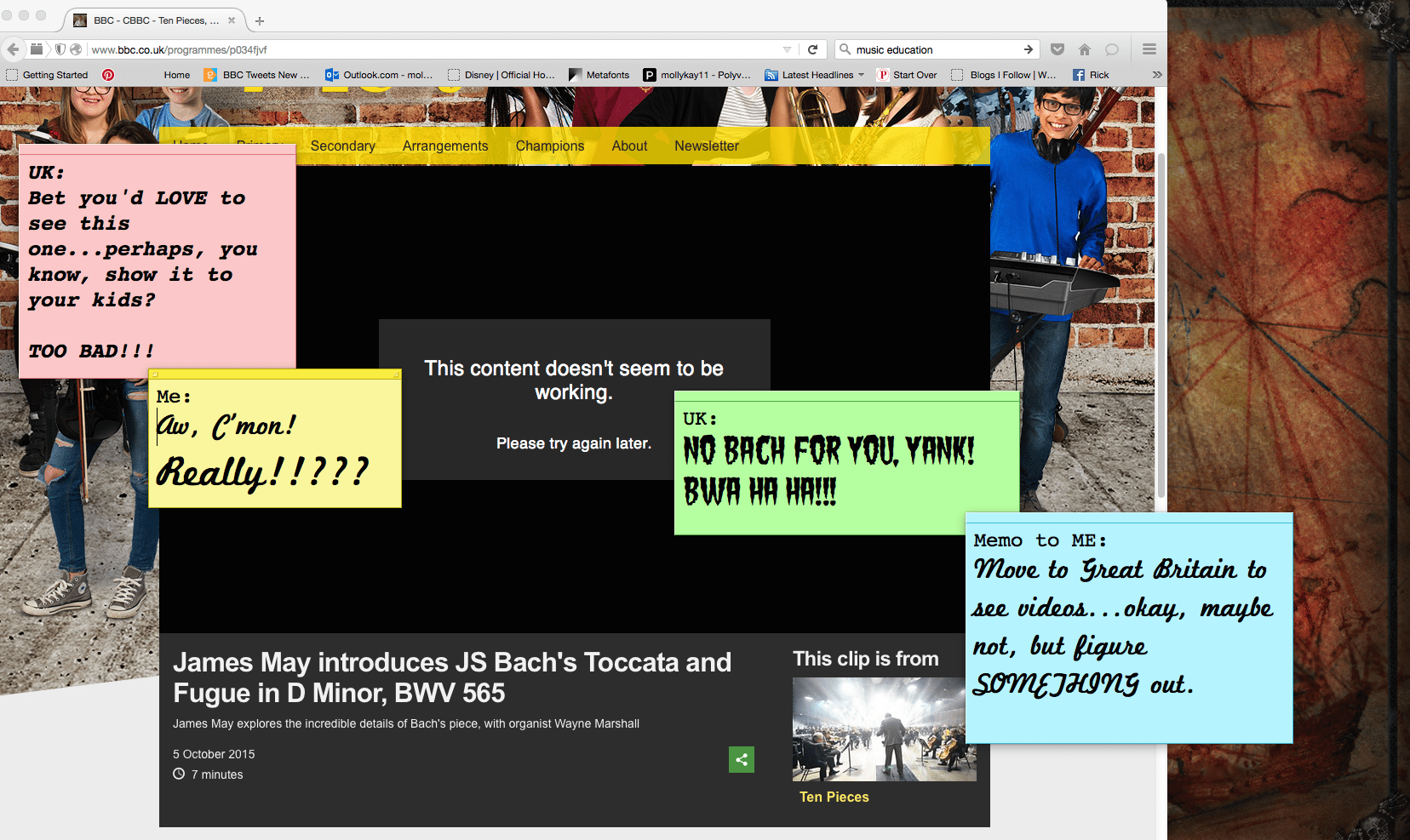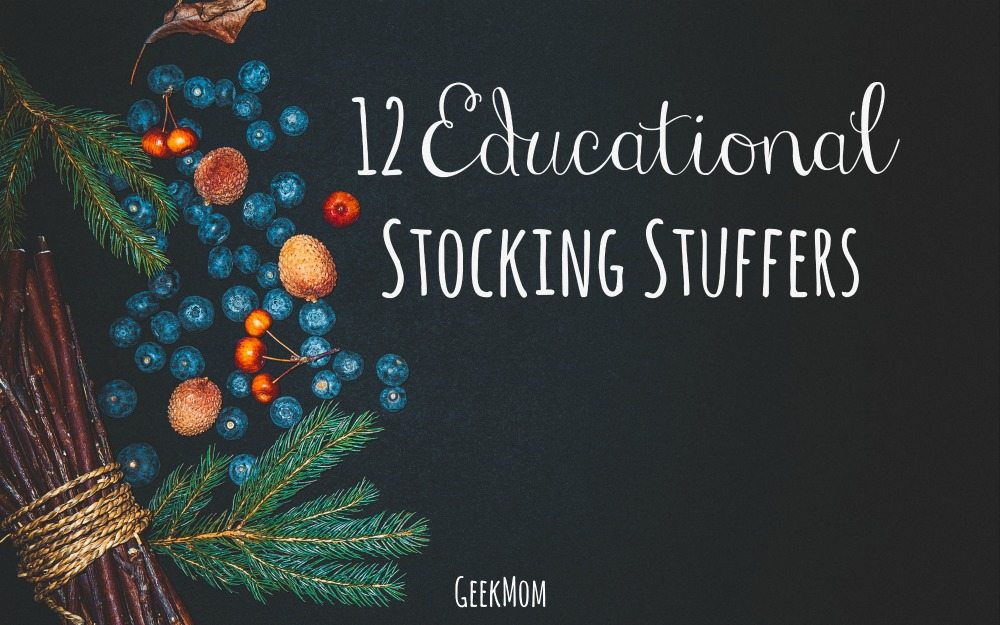
“Classical music is a little bit like having a spaceship. It can take you anywhere you want.”
— Dominic Wood (of CBBC’s Dick and Dom) in Ten Pieces.
We listen to a ton of music of all genres in our home. I’m proud to say my 6-year-old, who enjoys Yo-Yo Ma, can identify Johann Sebastian Bach’s Suite No. 1 in G Major for Solo Cello, BWV 1007, as quickly as she can The Ramone’s “Pet Sematery,” the latter of which she just recently quit referring to as “Don’t Put Me in the Berry.”
Over the past month leading up to Halloween, we had been playing several “dark classics,” including, among other pieces, Richard Wagner’s “Ride of the Valkyries,” and especially the goose bump-inducing Bach masterpiece Toccata and Fugue in D Minor.
Therefore, I tapped into the wonders of world-connecting Internet, as well as my insatiable journey for all things educational, and spiraled myself into a corner of frustration, as I tried to access the video content of BBC’s young people’s programming branch, CBBC’s, classical music film and outreach program for secondary schools, Ten Pieces II.
I had forgotten they were working on this until I ran across a Vimeo clip of one of my favorite actors, Christopher Eccleston, introducing “Ride of the Valkyries” for this project. It looked, for lack of a better phrase, absolutely fantastic. The production value was outstanding, and I couldn’t wait to see and share this entire film.
There are other cool aspects of the Ten Pieces II film, CBBC’s secondary level answer to last year’s successful Ten Pieces program and film for primary students. This included introductions by stand-up comic Vikki Stone and rapper Doc Brown, performance poetry with poet, musician, and educator, Chris Redmond, and a “Ten Pieces Megamix” presented by DMC World DJ Champion Mr Switch. The purpose of both these films is to introduce new generations to some of the world’s most celebrated classical pieces, as well as for use in a school curriculum.
However, the icing on the cake for me was with the opening piece, in which my personal creative muse, presenter James May, introduces, you guessed it, Bach’s Toccata and Fugue in D Minor, BWV 565.
Quick lesson for those who don’t know: “BWV” refers to the cataloging system of Bach’s work, or “Bach-Werke-Verzeichnis” in German. But, I digress.
I couldn’t wait to share these with my kids, as well as view them myself. Also, having both May and Eccleston introducing these pieces gave me reason to believe somebody out there created this program specifically for me (for use as an educational tool, of course).
Plus, CBBC offered a free DVD to secondary teachers, something my husband would have loved to apply for and use in his high school world history and geography classes, as he often discusses the artistic contributions of different eras and cultures.
Then, I saw that dreaded phrase: “Available for UK schools only.”
Of course, *sigh* of course.
Oooh, but they have the “chapterized clips” online, so we can just pull these up and watch them as we need them….or not:
“Sorry, CBBC games and videos can only be played if you’re in the UK,” so says the site.
Aaand, there you go. That location-limited practice sometimes called geo-blocking. This isn’t done out of spite, but rather, often to keep the licensing budget under control. Even so, it still feels like being left out of the “cool music kids” club.
Once again, I get to witness a resource with tremendous teaching and entertainment potential from another country, and am stymied by that little reminder social media hasn’t actually physically shortened the miles between the continents.
Now, obviously, I realize there’s a little bit of a geographic gap between North America and Europe, and it isn’t practical to supply American schools with free DVDs. Shipping cost alone is impractical. I am also aware licensing fees are a pain in the backside, when it comes to making video content accessible overseas. I completely understand this, but I don’t have to be happy about it.
The representative I contacted about this from the BBC Ten Pieces team was very helpful. She told me there is an ambition to make this film, which is funded by U.K. license payers, available internationally, but this likely won’t be a quick process. Fair enough.
This wouldn’t be the first time I’ve felt a little bit of international malcontent for lack of instant gratitude in the cyber world, but this latest disappointment had me thinking. Instead of grumbling about what I can’t access, I’ve come up with some ways to use what is available to us educators, parents, and music lovers west of the Atlantic.

Grab ALL the Downloadable Content Available.
Teachers from all over can access this free information–and CBBC happily provides this–including grade-specific arrangements of each piece, posters, composer profiles, lesson plans, and repertoires.
There is also audio content available in the form of free downloadable mp3s, performed by the BBC Philharmonic (Ten Pieces II) and BBC National Orchestra of Wales (Ten Pieces). Yes, these audio clips are accessible by everyone.
However, the Guide to the Orchestra eBook is available for U.K. devices only. Oh well.
Know Where to Dig for Videos…Legally.
There are ways for American viewers to see content on U.K. sites. BBC Worldwide on YouTube does have a CBBC channel as well. Currently, there aren’t any Ten Pieces II clips, but there are performances from the original Ten Pieces available for viewing.
Sometimes you can get lucky and find a clip on the BBC News Channels, but other times it will just link you back to the U.K.-only sites. The YouTube content is really the best bet.
Back in the day, we actually purchased a used DVD player so we could set it specifically for our U.K. purchased discs (we had accumulated a lot of Michael Palin travel discs). One would think it would be easier to convert videos online.
Well, if you’re really desperate to see something, there are legal VPN (Virtual Private Network) sites like TunnelBear intended to circumvent geo-blocking. I can’t really say I recommend this method, as I haven’t tried it. Seems risky for some reason. Plus, I’ve heard they don’t always work on every site. I’m just letting you know there are legal sites available, if you’re so inclined.
Of course in most of my cases, you can “wait it out.” It seems like all videos like these end up on YouTube or Vimeo eventually, and since it was one of these sites where I ran across the Eccleston/Wagner piece, as well as Dick and Dom’s introduction for “Mars” from Gustav Holst’s “The Planets” in the original Ten Pieces film, there’s a pretty good chance, others will follow. Just have patience.
Take Advantage of Good Old American DIY.
By using the downloadable resources that are available for everyone, it is actually easier to find video clips and audio downloads available to American viewers.
One of the resources from Ten Pieces is a downloadable repertoire. Use this to put together your own iTunes disc, since all of the pieces listed are easy to find and purchase. It may not be the arrangements used in the CBBC program, at least you’ll have a similar playlist.
I have to point out there are wonderful resources for American teachers out there just waiting to be discovered, from sheet music to online clips, and instrument-specific materials. The K-12 Resources for Music has links to hundreds of sites for educators and parents, but keep in mind not all of them are current or active.

Take advantage of these domestic resources and combine them with what you can from the CBBC programs. Find recordings by the New York Philharmonic or Boston Symphony Orchestra, to help illustrated the lesson plans provided online by CBBC. Come up with a fusion of the best of both sides of the pond.
As far as making this internationally available, maybe if enough interest were shown for these films from North American schools, I would like to see digital downloads offered for purchase for a nominal price. I’ll just put that thought out there, and walk away.
Classical music, and all music for that matter, is such a uniter of people from all over, it only seems right to pool the American and European programs and resources available, and really create something spectacular.
These Ten (or Twenty) Pieces are a good place to start.




